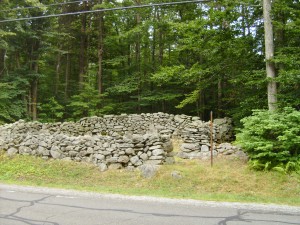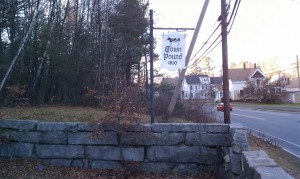Old Town Pounds To Dog Pounds
I first learned about the old stone town pounds in August 2010. It was in Becket, Massachusetts. (I wrote about our trip to Becket and briefly mentioned the pound here.) The Town Clerk told me and my sister about the old town pound, calling it “a cattle pen”. We went to look more closely at it, having passed it on our travels up and down the road. It is directly on Rte. 8 just north of the Town Hall. It wasn’t marked in any way, being only a stone structure along the side of the local road, a stone structure that you might take to be part of the common stone fences in New England until you looked more closely at it.

My sister got interested and later that fall sent me pictures from 3 different pounds in New Hampshire that she had either been aware of before, or had discovered in her area.
After she sent me the pictures I got more interested and started searching online for information about these old structures. I found a website titled Stone Structures of Northeastern United States which has a section on Town Pounds as well as lots of other information about a variety of stone structures, and about stone itself. I developed a vague plan to get her to show me the pound in Concord (Penacook) New Hampshire one day when we got together. She and I get together most months for dinner, or more recently lunch, since Concord is about half-way between our two homes.
Finally, this past November there was a nice day, not raining or snowing, and we went for a short drive to find the Penacook Pound (a repeat visit for her, first time for me). It turns out that this one is directly on Rte 3 north out of Concord. I wrote briefly about this in November when I was complaining about the busyness of getting ready for Thanksgiving (you can see what I wrote here if you can take my whining).


These pounds are dry stone built, meaning they are just stone piled on stone with no mortar or anything other than good construction holding them together. They tended (or are now anyway) to be about 5 feet high on the inside, and roughly rectangular. There is a small opening, just big enough for the largest animal to be contained to pass through, and this would have been barred by a gate of some sort. The ones in Becket and Penacook don’t have gates anymore. Some pictures of restored pounds show what a gate might have looked like.
Having decided it was time to write about these historic stone structures, I have done some more online researching. So far I haven’t found that elusive, definitive book that has all you could ever want to know about Town Pounds, but I have found bits and pieces of information. It seems that they existed in all the New England states, and in at least some they were required by the state when a town was officially established or incorporated. It looks to me like at least Connecticut still requires that there be a pound in a town. I haven’t done an exhaustive search of the state laws, I don’t have the patience for that, but a recent search found a site of Connecticut laws (thanks to Judy’s husband) that included the current requirement for a pound. Animal control is a community issue that carries forward into our own time. The animals in question may be different today, mostly stray dogs or cats although there is the occasional abandoned exotic pet, but the need for the community to control them hasn’t changed much.
I don’t know how far west the structures are found but haven’t run into sources showing them in New York or Ohio. There may have been equivalent structures that were called something else. In all likelihood the town pound goes back to the English villages that many of the early New England settlers came from. According to a Wikipedia article (here), the village pound was a feature of most British medieval villages. While various descriptions of their purpose can be found, it seems that in the earliest days of this country, roaming livestock of many varieties were problems for town or village residents. Thus, most commonly, the pound is described as being a place to contain roaming animals until the owner can claim them (and pay the fine). Cows and pigs were often the offenders, but any domesticated animal including fowl could be impounded. In some places a town might maintain a flock of sheep for the use of the townsfolk who would pay a fee to use them to crop down an area that was overgrown (like a meadow or field). This flock would also be kept in the pound. There are also reports that at least on occasion the town pound might be used to contain human offenders. The common thread was that a fee had to be paid.
In New England, while some of the earliest pounds may have been build with wood, stone seems to have been the preferred building material. Certainly the pounds that have survived, the ones I’ve seen or seen pictures of, were made of stone. And in New England there was, famously, an excess of stone to be found. Many a stone wall was reputedly built by a farmer pulling stones out of the field he wanted to plant and piling them along-side. In the two places where I have seen the still-standing stone walls, the pound was built on what is still a main road of the town on the outskirts of the boundary. Others I have read about but not yet seen have been swallowed by private property – perhaps having been built originally on a farmer’s land, or perhaps merely having been surrounded by the increasing population. In some places there was more than one town pound, to locate them conveniently to centers of population at the time. And happily, from the viewpoint of preserving some tangible examples of our history, town pounds have sometimes been rebuilt and taken care of by interested groups.

Leave a Reply